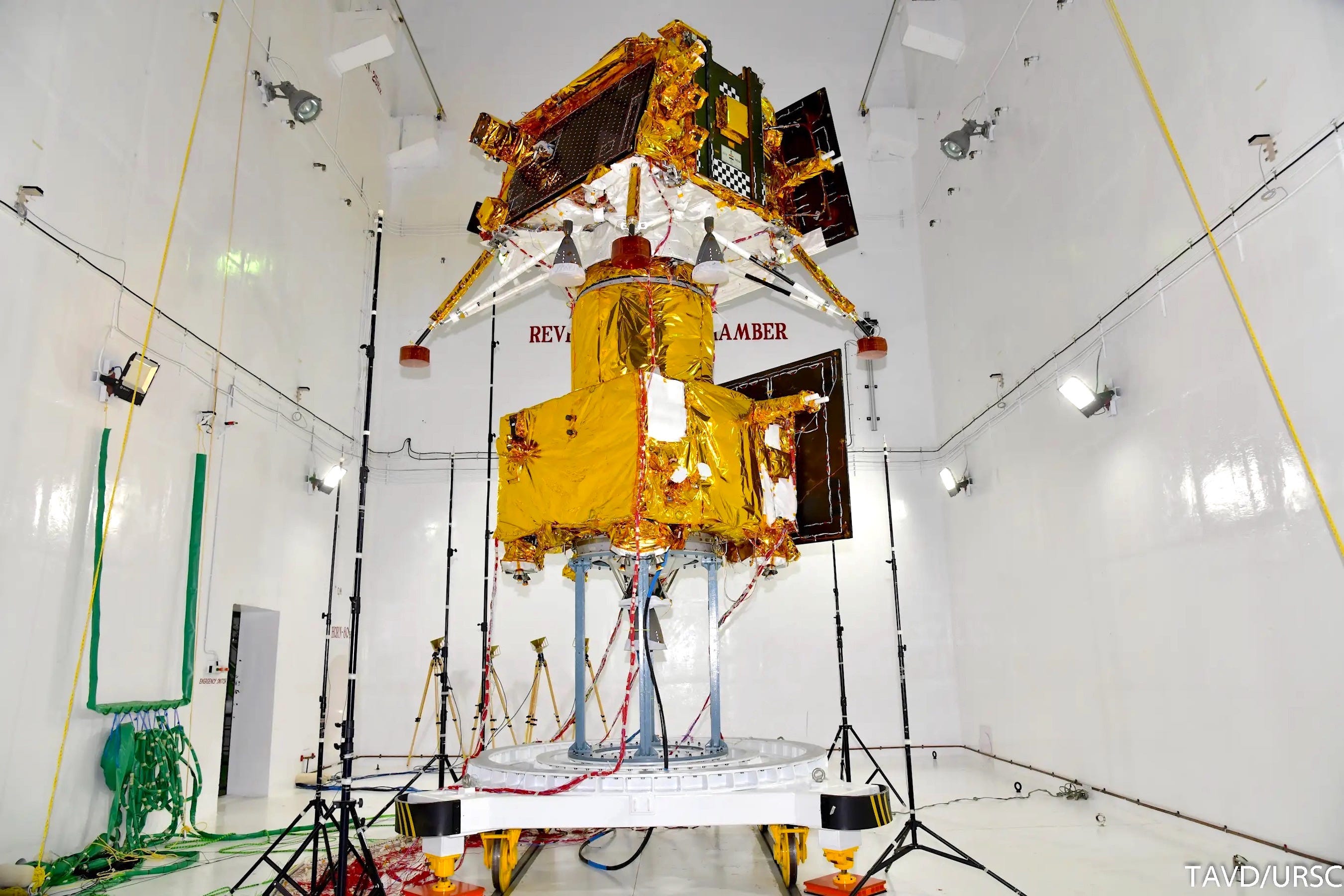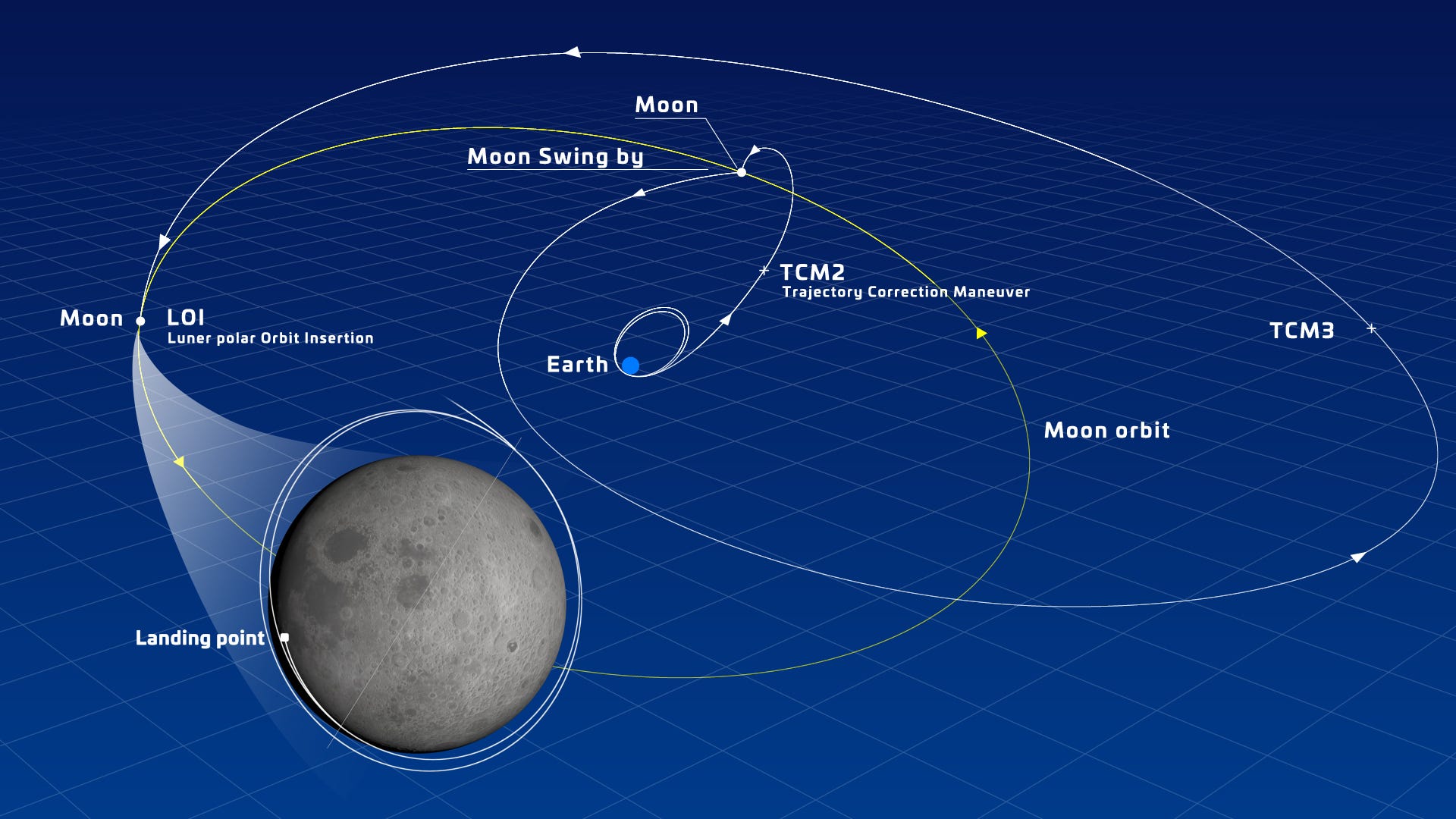Moon Monday #157: On maneuvering the Chandrayaan 3 orbiter back to Earth orbit, the upcoming trio of robotic lunar landers, infrastructure galore, and more
This is the last Moon Monday of 2023 as I take my year-end break to wind down an insanely busy year sprawling with conferences and talks over and above my canonical writing work. Alright, alright, I’m not done for the year just yet: expect a special story later this week and an exciting edition of my monthly Indian Space Progress report next week in your email or RSS inboxes. I shall then rest, refresh, reflect, and re-energize, and I hope you do too. ✨🌙
In another trick up its sleeve, ISRO pulls the Chandrayaan 3 lunar orbiter back to Earth orbit

In a surprising move, ISRO announced on December 4 that following several orbit-raising maneuvers and flybys, Chandrayaan 3’s propulsion module has returned from its ~150-kilometer polar lunar orbit to Earth orbit as of November 10. It was this propulsion module that carried the Chandrayaan 3 lander from its initial Earth orbit post-launch to one around the Moon. The two craft separated in a near-circular polar lunar orbit of 153 by 163 kilometers on August 17.
Between the Chandrayaan 3 lander’s unexpected last-minute hop, the propulsion module hosting experimental nuclear radioactive heating units, and this back-to-Earth maneuver, it’s great to see ISRO enter a mode of targeting extended mission objectives with Chandrayaan 3, something China has long been doing with its Chang’e missions for instance. As the most recent example, CNSA maneuvered the service module of the Chang’e 5 lunar sample return mission to the Sun-Earth L1 point in March 2021, and then brought it back to the Moon and put it in a Distant Retrograde Lunar Orbit in December 2021. ISRO says that bringing Chandrayaan 3’s propulsion module back to Earth orbit was informative in forging strategies for a future sample return mission while also avoiding creating unwanted lunar debris at the end of the module’s life.
Having said that, ISRO hasn’t provided a break-up of fuel consumed by the propulsion module during maneuvers from Earth orbit to the Moon and back. After the Chandrayaan 3 lander separated from the module on August 17, Chethan Kumar reported that the module had more than 150 kilograms of fuel remaining onboard. ISRO said at the time this will extend the module’s nominal 6-month life to several years. However, ISRO’s December 4 release states that after operating for a month in lunar orbit, the module had over 100 kilograms of fuel left. This could imply that unlike the Chandrayaan 2 orbiter, the Chandrayaan 3 propulsion module has been consuming or losing fuel faster than expected, and might better justify why ISRO placed the module in a very high Earth orbit of ~180,000 x ~380,000 kilometers—which wouldn’t have required much fuel. It would also help explain why the propulsion module had oddly dropped the Chandrayaan 3 lander in a ~150-kilometer lunar orbit instead of the originally planned and repeatedly publicly stated ~100-kilometer one!
Spinning the back-to-Earth-orbit maneuver as an aid towards sample return is perhaps a clever way for ISRO to secure funding for Chandrayaan 4, which aims to bring lunar material to Earth before end of decade. Recall that even the Chandrayaan 3 lander’s hop was spinned off as a sample return aid despite the fact that no such mission to date across Apollo, Luna, and Chang’e has had to demonstrate a hop before ascent. The hop would’ve been insightful nonetheless—just may be not uniquely so.
I wonder if instead of bringing the propulsion module back to Earth orbit if ISRO could’ve made it perform a controlled LCROSS-style crash into the Moon that the Chandrayaan 2 orbiter did follow-up observations on? That would’ve been cool too, and also helped towards ISRO’s stated goals of directly studying and extracting the Moon’s polar water ice.
A trio of robotic landers to aim for the Moon soon

- After JAXA’s SLIM lunar lander flew 5,000 kilometers past the Moon on October 4, its fuel-efficient trajectory is looping it back to Luna for an orbital insertion attempt on December 25. SLIM will then spend almost a month in lunar orbit—reducing its orbit size and performing operational checkouts—before attempting a 20-minute descent for a ‘pinpoint landing’ on January 20, 2024 at about 12 AM JST (3 PM UTC on January 19).
- ULA Chief Tory Bruno said on December 10 that the Vulcan rocket’s wet dress rehearsal will take longer to complete due to some persistent issues with the ground systems. As such, ULA will now likely target a four-day launch window starting January 8, 2024 to loft Astrobotic’s first Moon lander to Earth orbit instead of December 24. The lander will carry more than 12 payloads from 6 countries, including some micro-rovers. As part of NASA’s CLPS program, it was also supposed to carry 11 agency-funded instruments but will now only fly five.
- With the successful delivery of Intuitive Machines’ first Moon lander to SpaceX’s facility in Florida, the companies are targeting the lander’s launch on January 12, 2024. The mission, named IM-1, will carry six NASA science & technology payloads as part of CLPS. A separate, commercial telescope called ILO-X from Hawaii-based ILOA will also be aboard.
More mission updates
- Technicians are processing segments of the twin boosters that will power the second SLS rocket, which will push four astronauts towards the Moon on NASA’s Artemis II mission circa early 2025. All five segments of each booster are being inspected one-by-one before lifting them to a vertical position to stack and complete the boosters. The boosters provide about 75% of SLS’ thrust on launch.
- Australia’s first lunar rover will be fittingly called Roo-ver, as it was the most voted name in a public competition organized by the Australian Space Agency. Heading to the Moon’s south pole aboard a NASA-funded CLPS lander with an aspirational 2026 launch, the semi autonomous Roo-ver will fetch lunar soil for the lander, where a NASA-operated system will practice extracting oxygen from it as a technology precursor to eventually sustaining human presence on the Moon. The Australian Space Agency announced on March 20 competitively selecting two national industry consortia—AROSE, and the EPE & Lunar Outpost Oceania—to build a rover prototype by June 2024 for $4 million each. The agency will select a winning consortium to build the actual Roo-ver.
Many thanks to Epsilon3, Gurbir Singh, Nathan Price and Arun Raghavan for sponsoring this week’s Moon Monday. Join them!
Prepping for lunar infrastructure galore

DARPA announced on December 5 that 14 companies will participate and collaborate on its 10-year Lunar Architecture study (LunA-10) on how best to build key commercial infrastructure pieces for sustaining human presence on the Moon. DARPA did not specify which project each company will work on, or how much money it awarded each company, but some companies made independent announcements of their respective involvements:
- ICON will advance its work on building structures using lunar soil. Recall that last year NASA awarded a $57 million contract to ICON for continuing to develop construction technologies to build lunar surface infrastructure, with a test structure build targeted as early as 2026. Rachael Zisk has more details.
- Sierra Space will advance its NASA-funded carbothermal reactor using which researchers extracted oxygen from simulated lunar soil in a vacuum environment for the first time past April. Being built at an accelerated pace as part of NASA’s Game Changing Development program, the agency ultimately intends to demonstrate the system on the Moon via a future CLPS mission.
- GITAI, which recently moved its headquarters to the US from Japan, will explore how its under-development lunar rover with a two-meter inchworm robotic arm can help construct and maintain lunar infrastructure. The company has previously raised $61 million for said rover’s development for a hopeful 2026 launch. GITAI has been operating rover prototypes in the Mojave desert to test various activities related to assembling parts of lunar habitats.
- Firefly will explore how its “Elytra” vehicle can provide more lunar services such as docking, refueling, and repositioning spacecraft in cislunar space. Recall that on its first lunar mission, an Elytra craft will deliver and deploy the 280-kilogram Lunar Pathfinder spacecraft for ESA to lunar orbit in 2026 as part of a $112 million NASA CLPS contract.
- Honeybee Robotics will develop LUNARSABER, a proposed 100-meter tall deployable structure that will do a lot: from providing solar power to payloads and hardware at the Moon’s south pole—for which Honeybee won a NASA developmental award in 2022—to transferring power and providing navigation & communications to lunarbound machines. As if all of this wasn’t illuminating enough for a sustained lunar presence, the structure will also host gimbaled lights to literally illuminate local terrain and nearby permanently shadowed regions so as to enable more efficient operations for both robotic and human explorers. Color me impressed and electrified by this multi-purpose tower of lunar hope.
More Moon
- On December 6, Egypt became the eight country, 14th organization, and the first Arab nation to join the upcoming China-led long-term scientific base on the Moon’s south pole called the International Lunar Research Station (ILRS). Croatia-based non-profit Adriatic Aerospace Association was the 13th organization to join the ILRS when it signed up on November 28.
- A community of lunar scientists released the New Views of the Moon 2 as an add-on the original New Views of the Moon from 2006 to chiefly summarize the majority of lunar mapping and science results from the many worldwide orbital missions launched since 2006. Relatedly, India’s Chandrayaan 2 orbiter’s CLASS instrument team has released the largest and highest-resolution X-ray mapping of the Moon’s surface elements using orbital data collected over three years. Previously, CLASS provided us with the first ever global-scale sodium maps of Luna, sensed Chromium in its volcanic soil, and even detected energetic events from the Sun. Studying these datasets is unraveling specifics of how our Moon evolved and helping scientists constrain the lunar crust’s composition.
- In Phase 2, Level 2 of the $3 million Break the Ice Lunar Challenge, NASA has selected 6 teams out of 15 after each of their rover prototypes demonstrated how efficiently they could extract and transport icy regolith from terrestrial polar-Moon-like testbeds. The 6 winners will compete next year on a common, NASA-provided testbed to further demonstrate their systems in even more Moon-like conditions such as reduced gravity driving using offloading mechanisms.
- As part of TIFR Hyderabad’s outreach efforts under Sawaal Jawaab (Hindi for Questions & Answers), I will deliver a public talk titled “From Chandrayaan 3 to an Indian on the Moon” on December 16 at the Aaromalé Café. I will discuss the kinds of increasingly complex future Moon missions ISRO will undertake in the lead up to sending an Indian to dear Luna. Entry is free and open to all.

